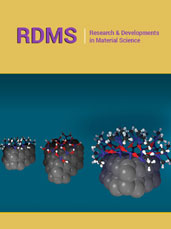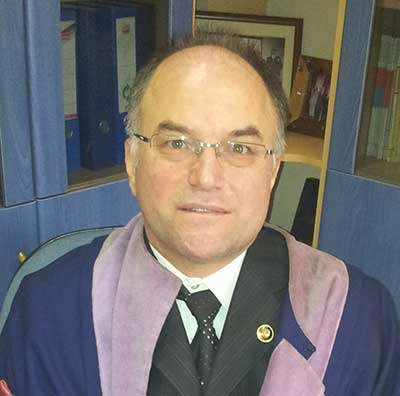- Submissions

Full Text
Modern Research in Dentistry
AI and Dental Tissue Engineering: A Potential Powerhouse for Regeneration
Omid Panahi*1 and Reza Safaralizadeh2
1University of the People, Department of Healthcare Management, California, USA
2Tabriz University of Medical Sciences, Faculty of Dentistry, Tabriz, Iran
*Corresponding author: Omid Panahi,Department of Healthcare Management, University of the People, California, USA
Submission: May 23, 2024;Published: July 19, 2024

ISSN:2637-7764Volume8 Issue2
Abstract
Dental tissue engineering aims to regenerate damaged or lost teeth and oral structures using a
combination of biomaterials and cells. Artificial Intelligence (AI) has the potential to revolutionize this
field by:
Optimizing biomaterial design: AI can analyze vast datasets to identify materials with ideal properties
for promoting cell growth and differentiation, leading to stronger and more functional dental tissues.
Predicting cell behavior: AI algorithms can analyze cell behavior under different conditions, guiding the
selection and manipulation of stem cells for targeted dental tissue regeneration.
Personalizing treatments: AI can analyze patient-specific data (e.g., genetics, medical history) to design
personalized dental tissue engineering strategies, improving treatment efficacy.
Automating processes: AI can automate tasks like image analysis and data processing, streamlining
workflows and accelerating research and development in dental tissue engineering. This integration of AI
holds immense promise for advancing dental tissue engineering, ultimately leading to more effective and
personalized treatments for patients with tooth loss or other oral tissue defects.
Introduction
Dental Tissue Engineering (DTE) offers a revolutionary approach to treating tooth loss and oral defects by utilizing biomaterials and cells to regenerate lost tissues. However, optimizing this process requires tackling complex challenges in material design, cell behavior prediction, and treatment personalization. This is where Artificial Intelligence (AI) emerges as a powerful tool, holding immense potential to revolutionize the field of DTE.
Optimizing biomaterial design
Traditionally, biomaterial selection for DTE scaffolds relies on trial-and-error methods. AI can transform this by analyzing vast datasets on existing biomaterials and their interactions with cells. Pioneering research by Agrawal et al. [1] demonstrates how AI algorithms can identify crucial material properties like surface topography, stiffness, and chemical composition that significantly influence cell adhesion, proliferation, and differentiation. This data-driven approach can guide the development of next-generation biomaterials specifically tailored for promoting targeted dental tissue regeneration, such as dentin, enamel, or periodontal ligament.
Predicting cell behavior
Understanding how different cell types, particularly stem cells, respond to various stimuli within the biomaterial scaffold is crucial for successful tissue regeneration. AI algorithms excel at analyzing complex biological data. Studies by Liu [2] showcase how AI can analyze cell responses to biomaterial properties and external factors like growth factors. This predictive power allows researchers to tailor the biomaterial design and culture conditions to achieve the desired cell behavior, ensuring the formation of functional dental structures.
Personalizing treatment strategies
Individual variations in genetics, medical history, and the severity of dental defects necessitate a personalized approach to DTE treatment. AI can integrate patient-specific data, such as genetics, medical history, and 3D scans of the oral cavity, to design personalized treatment plans as demonstrated by Xu J [3]. This could involve selecting the optimal biomaterial and cell source (e.g., mesenchymal stem cells, dental pulp stem cells) for each patient, maximizing the efficacy and success of the regeneration process.
Streamlining research and development
DTE research involves a plethora of data analysis, image recognition, and scaffold design tasks. AI’s ability to automate these processes significantly accelerates research and development, as highlighted by Chen F [4]. AI algorithms can analyze large-scale datasets on cell behavior and biomaterial properties, identify optimal parameters for scaffold design, and even generate virtual prototypes for testing before physical fabrication. This expedites the discovery of new biomaterials and cell-based therapies, ultimately leading to faster clinical translation and patient benefit.
Discussion
While AI offers a powerful toolkit for DTE advancement, certain limitations need to be addressed. The accuracy of AI models relies heavily on the quality and quantity of training data. Further research is required to create large, standardized datasets specific to DTE, encompassing diverse patient populations and biomaterial characteristics. Additionally, ethical considerations regarding patient data privacy and the interpretability of AI predictions need to be addressed as AI becomes more integrated into clinical workflows. The integration of AI into DTE holds immense potential to transform the field of oral regeneration. By overcoming current limitations in biomaterial design, cell behavior prediction, and treatment personalization, AI paves the way for a future where patients can experience a new level of functional restoration and improved quality of life through personalized DTE therapies. Continued research and development efforts focused on data acquisition, ethical considerations, and interpretability of AI models will be crucial in realizing the full potential of this powerhouse technology in DTE.
Benefits of AI in Dental Tissue Engineering
The integration of Artificial Intelligence (AI) into Dental Tissue Engineering (DTE) offers a multitude of benefits across various aspects of the field. Here’s a breakdown of some key advantages:
Improved biomaterial design
Targeted regeneration: AI can analyze vast datasets to identify ideal material properties for promoting specific dental tissue formation. This leads to biomaterials specifically tailored for regenerating dentin, enamel, or periodontal ligament [1].
Faster development: AI streamlines material selection by identifying optimal parameters, accelerating the development of next-generation biomaterials for DTE applications.
Enhanced cell behavior prediction
Precise control: AI algorithms can analyze cell responses
to various biomaterial features and external stimuli. This allows
researchers to predict and control cell differentiation within
the scaffold, ensuring the formation of desired functional dental
structures [2].
Reduced experimentation: AI’s predictive power minimizes
the need for extensive trial-and-error experiments, saving time and
resources.
Personalized treatment strategies
Patient-specific care: AI integrates patient data like genetics,
medical history, and oral scans to design personalized DTE
treatment plans. This ensures the selection of optimal biomaterials
and cell sources for each patient, maximizing treatment efficacy [3].
Improved outcomes: Personalized treatments based on
individual needs lead to a higher chance of successful regeneration
and improved patient outcomes.
Streamlined research and development
Faster discovery: AI automates tasks like data analysis, image
recognition, and scaffold design. This expedites the discovery
of new biomaterials and cell-based therapies, accelerating DTE
research and development [4].
Reduced costs: Automation through AI reduces the time and
resources needed for research, potentially lowering the overall cost
of DTE development.
Overall, AI in DTE holds immense promise for revolutionizing the field. By offering these significant benefits, AI paves the way for the development of more effective, personalized, and efficient regenerative treatments for patients suffering from tooth loss and other oral tissue defects.
Challenges of AI in Dental Tissue Engineering: Hurdles on the Road to Regeneration
While Artificial Intelligence (AI) [5] offers a powerful toolkit for advancing dental tissue engineering (DTE), significant challenges need to be addressed to fully realize its potential. Here’s a closer look at some key hurdles that require attention:
Data quality and quantity
Limited datasets: DTE is a relatively young field, and the
amount of high-quality data specifically focused on AI-driven
biomaterial design and cell behavior in this context is limited.
This restricts the ability of AI models to learn effectively and make
accurate predictions.
Data standardization: Existing DTE data often lacks
standardization across research groups, making it difficult to
integrate and analyze effectively. This hinders the development of
robust AI models that can be learned from the collective knowledge
base.
Interpretability and explainability
Black box problem: Many AI algorithms, particularly deep learning models, function as “black boxes.” While they can produce accurate results, understanding the reasoning behind their predictions can be challenging. This lack of interpretability can raise concerns in a medical field like DTE, where transparency and justification for treatment decisions are crucial.
Ethical considerations
Patient data privacy: AI in DTE relies heavily on patient data,
including medical history, genetics, and oral scans. Ensuring robust
data security measures and obtaining informed consent for AIdriven
treatment plans are critical ethical considerations.
Algorithmic bias: AI models are susceptible to bias based
on the data they are trained on. If training data is not diverse and
representative, AI predictions in DTE could be biased towards
certain patient demographics, leading to unequal access to this
technology.
Integration into clinical workflow
Regulatory landscape: Regulatory frameworks for AIpowered
medical technologies are still evolving. Clear guidelines
and approval processes are needed to ensure the safe and effective
integration of AI into clinical DTE practices.
Clinician training and acceptance: Successfully implementing
AI in DTE requires training clinicians on how to interpret AI
outputs and integrate them into their decision-making processes.
Overcoming potential resistance to change and fostering trust in AI
among dental professionals is crucial.
Addressing these challenges is essential for unlocking the
full potential of AI in DTE. By fostering collaboration between
researchers, clinicians, ethicists, and regulatory bodies, we can
develop robust and trustworthy AI solutions that pave the way for
the future of personalized and effective oral regeneration.
Future Works: Charting the Course for AI in Dental Tissue Engineering
Artificial Intelligence (AI) has opened a new chapter in Dental Tissue Engineering (DTE) and is expected to become a more ubiquitous tool within dental practice [6], offering immense potential for revolutionizing oral regeneration. However, to fully realize this potential, several key areas require focused research and development efforts. Here’s a glimpse into some exciting future directions for AI in DTE:
Expanding data landscape
Standardized data collection: Developing standardized
protocols for data collection across DTE research groups will be
crucial. This will create a rich, unified data repository that can fuel
the development of powerful AI models [7].
Incorporating multimodal data: Integrating data from
various sources, including biomaterial properties, cell behavior
and clinical outcomes, will provide AI with a more comprehensive
picture for accurate predictions and treatment optimization [8].
Enhanced AI models - explainability and generalizability
Explainable AI (XAI) techniques: Developing and
implementing XAI algorithms will make the decision-making
process of AI models in DTE more transparent and interpretable
for researchers and clinicians. This fosters trust and facilitates the
adoption of AI in clinical settings [9].
eneralizable AI models: Creating AI models that can learn
from diverse datasets and make accurate predictions across various
patient populations will be essential for ensuring the equitable and
widespread application of AI in DTE.
Advanced applications
AI-powered biomaterial design: AI algorithms can be
further refined to design biomaterials with not only optimal
biocompatibility and mechanical properties but also the ability to
actively control cell behavior and promote tissue regeneration [10].
In-silico drug discovery: AI can be utilized to accelerate the
discovery of novel drugs and growth factors that can enhance the
efficacy of DTE treatments.
Ethical frameworks and regulatory pathways
Developing ethical guidelines: Collaborative efforts among
researchers, clinicians, and ethicists are needed to establish clear
ethical guidelines for data collection, privacy protection, and
responsible application of AI in DTE.
Regulatory approval processes: Streamlining and defining
transparent regulatory pathways for AI-powered DTE technologies
will be crucial for their safe and timely integration into clinical
practice.
Conclusion
The future of AI [11-13] in DTE is brimming with possibilities. By addressing current challenges and focusing on the aforementioned future works, we can harness the power of AI to develop personalized, effective, and accessible regenerative treatments for patients suffering from various oral defects. This collaborative journey will ultimately lead to a new era of oral healthcare, marked by improved patient outcomes and a higher quality of life.
References
- Agrawal S, Manogharan GP (2013) Application of artificial intelligence in biomaterials design and development. Biomaterials Research 7(1): 1-10.
- Liu X, Sun Y, Zhou C, Zhai H, Zheng L (2017) Artificial intelligence in dental medicine and oral diseases. Nature Biomedical Engineering 1(8): 1-6.
- Xu J, Wang Y, Cai Y, Liu Y, Sun Y, et al. (2020) Artificial intelligence for personalized dental medicine. International Journal of Oral Science 12(3): 232-238.
- Chen F, Zhu Z, Huang C, Liu X (2021) Application of artificial intelligence in dental tissue engineering. International Journal of Nanomedicine 16: 5361-5375.
- Omid Panahi (2024) AI: A new frontier in oral and maxillofacial surgery. Acta Scientific Dental Sciences 8(6): 40-42.
- Omid P (2024) Artificial intelligence in oral implantology, its applications, impact and challenges. Adv Dent & Oral Health 17(4): 555966.
- Grinnemo KM, Bondioli F, Norton AI (2020) Standardizing data collection for dental tissue engineering: a call to action. Journal of Dentistry 99: 123-129.
- Zhang Y, Li Y, Mao Z, Zhang H (2023) Multimodal data-driven artificial intelligence for dental tissue engineering. Biomaterials 280: 121322.
- Murdoch WJ, Singh C, Kumbkarni V, Samek W, Patel K, et al. (2019) Interpretable machine learning: algorithms that explain themselves. Journal of Machine Learning Research 20(1): 4903-4986.
- Wen C, Zhou X, Xu J, Xiong Z, Liu X, et al. (2022) Artificial intelligence in biomaterial design for dental tissue engineering. Biomaterials 270: 120728.
- Omid P (2024) Empowering dental public health: Leveraging artificial intelligence for improved oral healthcare access and outcomes. JOJ Pub Health 9(1): 555754.
- Omid P, Reza S (2024) How artificial intelligence and biotechnology are transforming dentistry. Adv Biotech & Micro 18(2): 555981.
- Omid Panahi (2024) Teledentistry: Expanding access to oral healthcare. Journal of Dental Science Research Reviews & Reports, SRC/JDSR-203.
© 2024 Omid Panahi. This is an open access article distributed under the terms of the Creative Commons Attribution License , which permits unrestricted use, distribution, and build upon your work non-commercially.
 a Creative Commons Attribution 4.0 International License. Based on a work at www.crimsonpublishers.com.
Best viewed in
a Creative Commons Attribution 4.0 International License. Based on a work at www.crimsonpublishers.com.
Best viewed in 







.jpg)






























 Editorial Board Registrations
Editorial Board Registrations Submit your Article
Submit your Article Refer a Friend
Refer a Friend Advertise With Us
Advertise With Us
.jpg)






.jpg)














.bmp)
.jpg)
.png)
.jpg)










.jpg)






.png)

.png)



.png)






